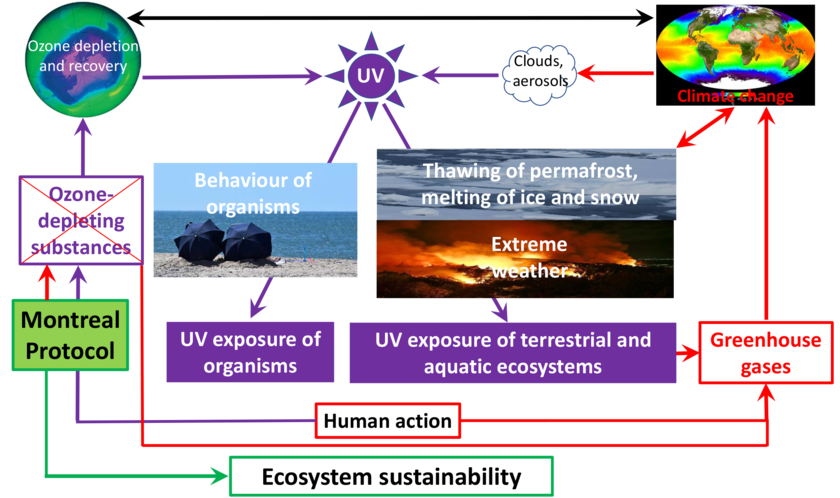News Detail
Montreal Protocol prevents depletion of ozone layer, but…
September 17, 2019 |
The Montreal Protocol on Substances that Deplete the Ozone Layer, which celebrated its 30th anniversary in 2017, was the first UN multilateral environmental agreement to be universally ratified (197 Parties by 2008). The aim of this treaty is to protect the stratospheric ozone layer – essential for life on Earth – by phasing out the production and controlling emissions of ozone-depleting substances (chlorofluorocarbons, CFCs). Stratospheric ozone absorbs solar ultraviolet-B (UV-B) radiation, which has harmful effects on humans and other organisms. The Montreal Protocol has been highly successful: global mean total ozone is expected to recover to pre-1980 levels by 2050 – provided that the Protocol is fully complied with. It was recently reported, however, that the decline in atmospheric concentrations of trichlorofluoromethane (CFC-11) has slowed down since 2012. The sources of increased CFC-11 emissions have been identified, with 40 to 60 per cent coming from China. Most of the ozone-depleting substances banned by the Montreal Protocol are also potent greenhouse gases: modelling studies indicate that, in the absence of the Protocol, global mean temperatures would have risen more than 2°C by 2070 owing to the warming effects from these substances alone. The Protocol is thus helping not only to protect the stratospheric ozone layer but also to combat global warming.
Antarctic ozone hole affecting the climate in the Southern Hemisphere
Despite the recovery of stratospheric ozone, seasonal thinning of the ozone layer over Antarctica has been observed annually since the 1980s, although the extent of the spring “ozone hole” has declined. As well as increasing UV radiation in Antarctica, this ozone depletion is contributing to (CO2‑related) climate change across much of the Southern hemisphere by altering atmospheric circulation patterns; these in turn affect regional weather conditions, with some areas becoming wetter and others drier. For example, ozone-driven climate change has exacerbated droughts in Chile, increasing the risk of wildfires. At the same time, changing patterns of rainfall in southeastern South America have led to increased agricultural productivity. These changes in weather conditions also affect aquatic ecosystems: for example, increased water temperatures are associated with a decline in corals along the coast of Brazil.
Climate change influencing UV exposure of ecosystems
One of the consequences of drier conditions is that terrestrial ecosystems are exposed to increased solar UV radiation, as shade from trees and other vegetation is reduced. Photochemical reactions (induced by UV and visible radiation) in decaying natural organic matter, such as plant litter, lead to the formation of CO2 and other greenhouse gases. Thus, extended droughts, driven by climate change, mean that not only is less CO2 absorbed by plants via photosynthesis, but more CO2 is released due to photodegradation of organic matter. As a result of the thawing of permafrost, melting of glaciers and more intense precipitation, inputs of dissolved organic matter to rivers, lakes and coastal waters are increasing. Here, as a result of increased exposure to UV radiation, it can undergo photodegradation, with CO2 and other gases being emitted. This process reduces the net absorption of CO2 by aquatic ecosystems.
The extent to which organisms are exposed to UV radiation also depends on behaviour patterns. For example, the increased incidence of skin cancer over the last century appears to be largely attributable to changes in behaviour that increase exposure to solar UV radiation. Many animals and plants migrating to higher altitudes as a result of climate change will be exposed to more intense UV radiation.
Further information
The review article by Barnes et al. is based on seven chapters from the latest quadrennial report (2018 Assessment Report) of the UNEP Environmental Effects Assessment Panel (EEAP). The UNEP EEAP is one of the three assessment panels, established in 1988 by the Parties to the Montreal Protocol, which produce an Assessment Report every four years. The seven chapters from the 2018 Assessment Report of the UNEP EEAP were also published in a special issue of Photochemical & Photobiological Sciences (2019, 3: 595–828).
References
Barnes, P. W. and others, Ozone depletion, ultraviolet radiation, climate change and prospects for a sustainable future, Nature Sustainability, 2019, 2: 569-579.
Montzka, S. A. and others, An unexpected and persistent increase in global emissions of ozone-depleting CFC-11, Nature, 2018, 557: 413-417.
Rigby, M. and others, Increase in CFC-11 emissions from eastern China based on atmospheric observations, Nature, 2019, 569: 546-550.


